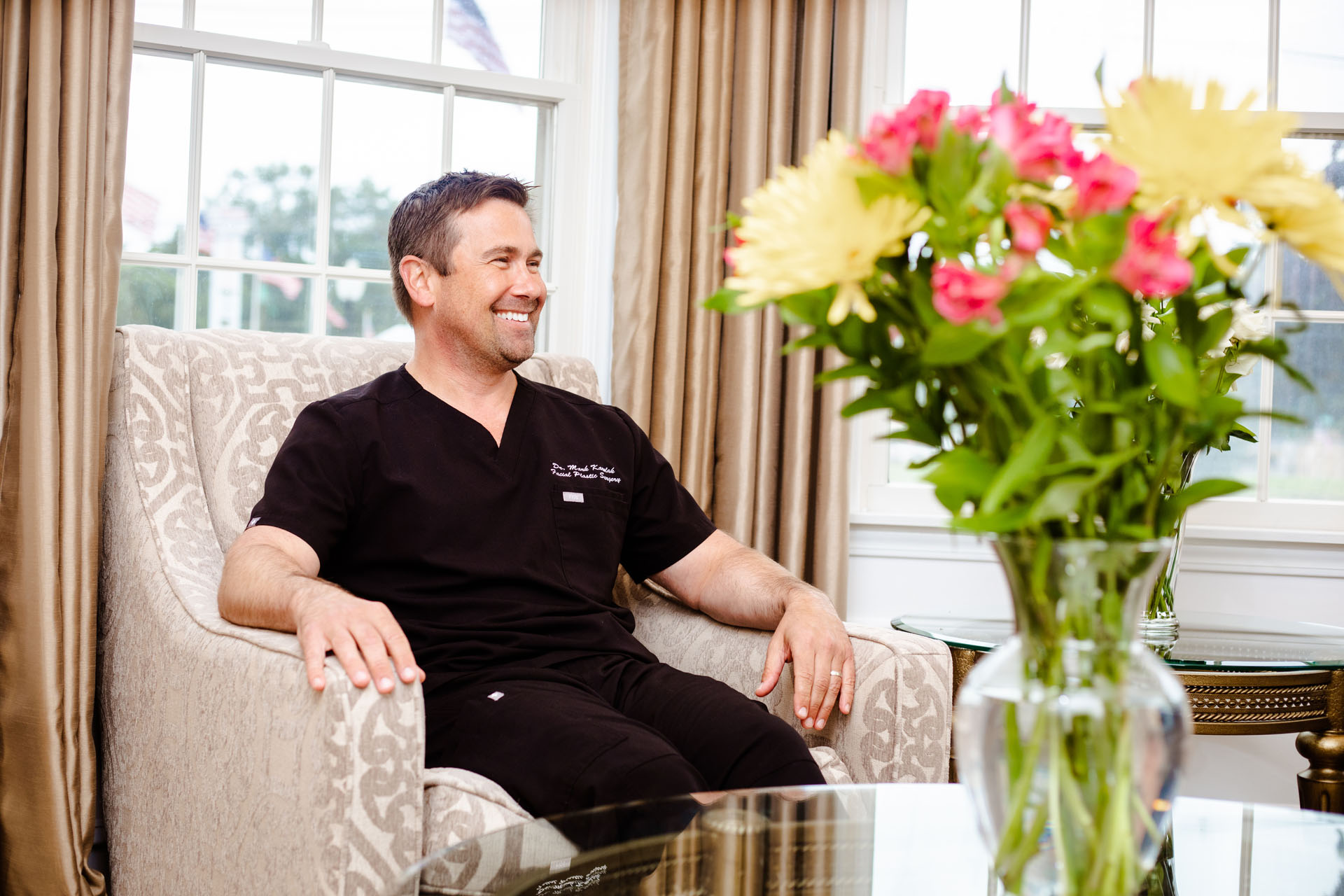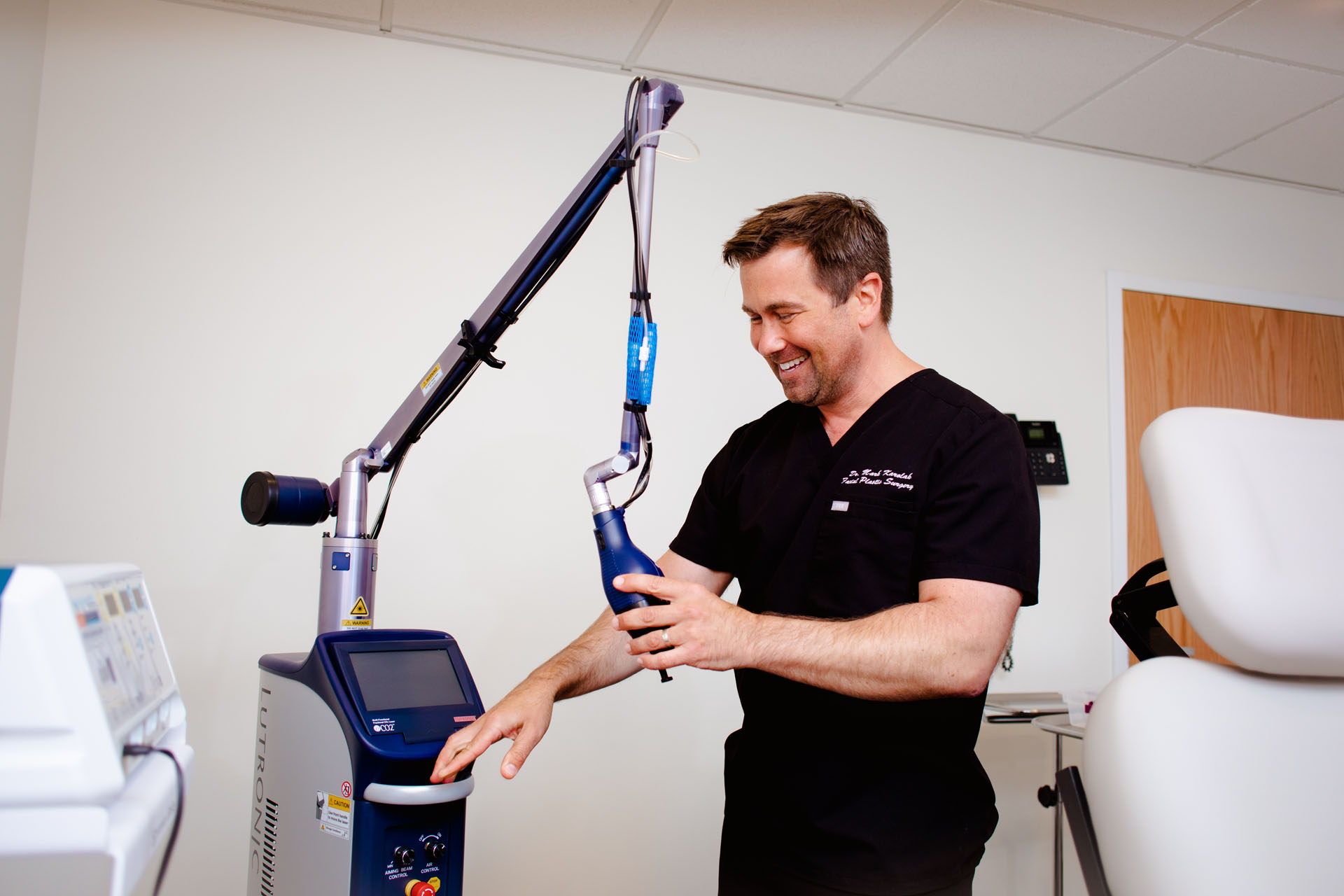AFTER MORE THAN 3,000 FACELIFTS PERFORMED AND COUNTING, WHAT’S THE SECRET BEHIND THIS FACIAL PLASTIC SURGEON’S GROUNDBREAKING AESTHETIC? TO MAKE IT LOOK AS IF HE WERE NEVER THERE
BY AMANDA McCOY • PHOTOS BY ALEX BARETTO
As a young student, Dr. Mark Karolak, D.O., F.A.O.C.O., was immediately drawn to the sciences. When his classmates cringed during dissections in high school biology, he was fascinated. “I remember feeling medicine was the career path for me,” he recalled, though it wasn’t until a chance encounter at a fundraiser his freshman year of college that his vocational course became clear.

“I met a plastic surgeon from California, and I was awe stricken,” noted Dr. Karolak, a native of Wayne and father of three. “I thought, that’s the rockstar of medicine. I wanted to learn everything about what she does and what it took to get there.” From that day forward, the aspiring plastic surgeon remained laser focused. After receiving his bachelor’s degree in biology from Rutgers University, he Aattended med school at the University of Medicine and Dentistry of New Jersey (now Rowan University Osteopathic Medical School), followed by the otolaryngology and facial plastic surgery program at the Saint Barnabas Healthcare System, where he served his residency. During rotations early in his training, he was kindled by head and neck surgery particularly in cosmetics.
“What appealed to me was that there was a lot to be done not just functionally but cosmetically, and after a year in practice I knew this was where I wanted to focus. As competitive as it is, in 2006 I decided to focus on facial plastic surgery and making people look like the best versions of themselves – younger and more refreshed.”
Though a plastic surgeon by title, the doctor eschews the word “plastic” in appearance. He specializes in the face and neck area, including facelifts, neck lifts, eyelid lifts, fat transfer, facial sculpting, laser treatments, fillers, and Botox at his Jersey Shore office.

“I realized early on in practice that I would be more successful doing something I truly love and have a passion for rather than trying to do everything that’s out there,” he noted. “So I focus on a few procedures that really capture the way people used to look and help them look more rejuvenated – doing that well and doing that every day.”
Per the doctor, achieving natural results is an amalgamation of art, technique, and timing. He performs every consultation himself to educate patients on the aging process, find out their individual goals and expectations, and offer his recommendations based on factors like skin quality, facial volume, muscle looseness, et al.
“They always see me,” he said. “They don’t see a consultant; I’m looking at them with my eyes and they are getting my recommendations. They will know what will work and what won’t.”
If the doctor believes the patient is not yet a candidate for surgical action, he’ll suggest a less invasive alternative, such as skin resurfacing with the powerful Lutronic eCO2 fractional laser. This minimally invasive treatment does wonders for improving skin quality and tightness and addresses age-related issues like sun damage and fine lines.
If a person’s best treatment option does indeed involve incision, the doctor employs techniques that lessen the severity and risks. Patients, for example, won’t find a general anesthesiologist in the treatment room.

“A unique part of our practice is that we use local anesthesia. Patients aren’t wide awake; they get relaxing and numbing medicine, and they are usually dozing in and out throughout the procedure. It keeps their muscles from being paralyzed and eliminates the initial comedown or lingering effects caused by general anesthesia.”
The age at which a person is ready for a facelift or other surgical procedures (such as fat transfer or neck lifts) varies, but the doctor explained that acting early will yield better results as the skin and muscles continue to loosen as patients get older.
“There is no magical right age [for a facelift],” he said. “People have to ask themselves, ‘At what age will I be able to enjoy this the most?’ One of the biggest transitions in my practice since the time I started was the age range in patients for facelifts. When I began, it was 55-70, and now it’s 45-60; it’s dropped an entire decade.”

For facelifts, the doctor employs a technique that focuses on tightening the muscle rather than pulling the skin. Because more work is performed underneath the skin’s surface, it moves the muscles into a more youthful position, and any excess skin is then removed. Cheek lifts are also often enlisted to address muscle looseness. “Deep-plane facelifts allow me to work mainly on the support structures of the face, which would be the muscles,” explained the doctor. “Once the muscles are repositioned, that leads to a more natural look.”
Though the stigma of surgical procedures has certainly waned since the Real Self Top Doctor first began practicing he noted that building a word-of-mouth clientele in the early aughts was difficult as no one wanted to reveal they had undergone a facial procedure he still encounters occasional trepidation. But after 3,000 facelifts performed, his resume now walks all throughout Monmouth County, from offices to family gatherings.
“The biggest fears on people’s minds have always been looking like they were operated on and not like themselves. One of the most common comments patients make is their kids are worried they won’t recognize them, but my track record shows these patients will look natural, and that support then becomes stronger from their families. Patients will ask if they can see their before photos and their mouths drop. They say, ‘I don’t remember looking like that,’ and that they wish they would’ve done this sooner.”

Looking ahead at his next 16 years in practice, Dr. Karolak expects the momentum will continue on its current trajectory and society will become even more receptive to the benefits of cosmetic surgery. He’s also noticed a surge in preventive skincare in teenagers and young adults, which will make maintenance as they age even easier. “The hardest thing to rejuvenate is skin that’s gone through so much damage over their lifetime and has no elasticity,” he said. “You can remove excess skin but you can’t improve elasticity. If you can maintain it throughout life up to the point where you may need a face lift, you will be working with better skin so your results will be better.”
Dr. Mark Karolak Facial Plastic Surgeon
2101 NJ-34 Suite D, Wall Township
732.314.6727
DrKarolak.com
